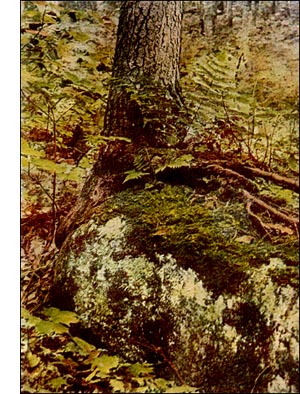Rose Bryum Moss
 The Rose Bryum, Bryum roseum, Schreb.
The Rose Bryum, Bryum roseum, Schreb.Habit and habitat.-Bryum roseum is one of the largest and showiest of the Bryums known outside the tropics. It is found in shaded woods at the bases of trees and decayed logs. Under favourable circumstances this species forms tufts, but usually the plants are scattered among other mosses.
Name.-The specific name refers to the rose-like arrangement of the crown leaves, Latin roseus, a rose.
Plant (gametophyte).-Fine and large, stems 1 to 2 inches long, with few branches; creeping stems (stolons) present, from which new plants arise.
Leaves.-At the apex crowded to form a rosette, each leaf spatulate; apex taper-pointed; margin acutely toothed from the middle upward, reflexed to the base, wavy when dry; vein (costa) broad and reddish at the base, narrowed upward and produced beyond the apex; cells loose and filled with chlorophyll. Stem-leaves lying close to the stem, oblong-lance-shaped, small and thin.
Habit of flowering.-Male flowers in separate tufts from the female flowers (dioicous), arranged at the apex of the stems and surrounded with radiating leaves.
Veil (calyptra). - Split up one side.
Spore-case.-Single or in clusters, oblong-conical, pendent, and slightly incurved, solid and not constricted under the mouth when dry.
Pedicel (seta).-Dark purple, long and solid. 1 to 1 1/2 inches high.
Lid (operculum).-Slightly convex with a tiny nipple in the centre, dark-purple.
Teeth ( peristome). - Very long, inner segments orange-coloured, perforated along the keel.
Annulus.-Compound, rolling back as the lid falls.
Spores.-Mature in autumn.
Distribution.-On the Eastern and Western slopes of North America, also in Europe, Asia and Africa.